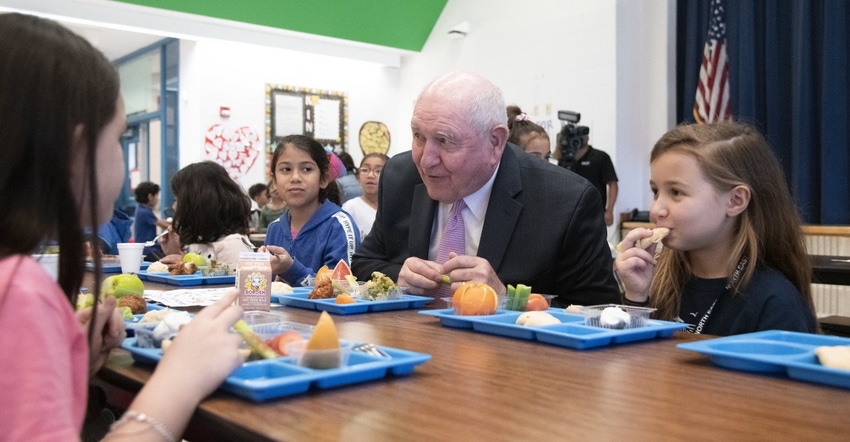USDA to leverage summer food programs through school year to provide meals during ongoing pandemic.
October 13, 2020

The U.S. Department of Agriculture extended flexibilities to allow free meals to continue to be available to all children throughout the entire 2020-21 school year. The agency said this “unprecedented move is part of USDA’s unwavering commitment to ensuring all children across America have access to nutritious food as the nation recovers from the COVID-19 pandemic.”
USDA previously extended child nutrition waivers through December 2020 based upon available funding at the time. The flexibilities extended in this announcement will allow schools and other local program operators to continue to leverage the Summer Food Service Program (SFSP) and the Seamless Summer Option (SSO) to provide meals to all children at no cost -- available at more than 90,000 sites across the country -- through June 30, 2021.
“As our nation recovers and reopens, we want to ensure that children continue to receive the nutritious breakfasts and lunches they count on during the school year, wherever they are and however they are learning,” Agriculture Secretary Sonny Perdue said. “We are grateful for the heroic efforts by our school foodservice professionals who are consistently serving healthy meals to kids during these trying times, and we know they need maximum flexibility right now. I appreciate President [Donald] Trump for his unwavering commitment to ensuring kids receive the food they need during this pandemic and for supporting USDA in continuing to provide these unprecedented flexibilities.”
Kimberly Alessandroni, director of Child Nutrition Services, Northeastern School District, said the district “has implemented the USDA waiver to offer all students free meals utilizing the SSO program. We have been able to offer free meals to all students in person (brick and mortar) and through curbside pickup for virtual students. I am extremely proud of my staff and their flexibility to do their best to keep school meals as normal as possible during a pandemic. The Child Nutrition Staff have wanted to continue hot meals for students and wanted to offer their favorite meal choices.”
“These waiver extensions are great news for America’s students and the school nutrition professionals working so hard to support them throughout this pandemic," School Nutrition Assn. president Reggie Ross said. “Families struggling to make ends meet can be assured that their students will have access to healthy school meals, whether they are learning at home or in school. School meal programs can remain focused on safely meeting nutritional needs of children in their communities without having to worry about burdensome regulations. The School Nutrition Assn. appreciates USDA’s ongoing efforts to address the many challenges our members have faced while working on the frontlines to feed hungry children.”
USDA said it understands that a one-size-fits-all approach is not an effective way to feed children, particularly during the current challenges the country is facing. USDA can extend these waivers due to language in the continuing resolution signed into law by the President at the end of September.
Matt Herrick, senior vice president of communications for the International Dairy Foods Assn., said the school meal flexibility will be a critical step by the federal government toward addressing food insecurity and nutrition needs of children across the country during this pandemic.
“Roughly 7-8% of all milk produced in the United States flows to students in our public schools, providing nine essential nutrients that all children need to stay healthy and thrive. Milk and dairy products are critical in the diets of children. In fact, milk is the top source of calcium, potassium, phosphorus and vitamin D in kids ages 2-18. These flexibilities ensure more children have access to nutritious dairy products at a challenging time for many families,” Herrick said.
USDA is extending waivers through June 30, 2021, that:
Allow SFSP and SSO meals to be served in all areas and at no cost;
Permit meals to be served outside of the typically required group settings and meal times;
Waive meal pattern requirements, as necessary, and
Allow parents and guardians to pick up meals for their children.
These program flexibilities allow schools and local program operators to operate a meal service model that best meets their community’s unique needs while keeping kids and staff safe. Additional flexibilities are being granted on a state-by-state basis, as required by law, to facilitate a wide range of meal service options and accommodate other operational needs.
Early in the pandemic, USDA adapted its summer feeding site finder to ensure that parents and children would be able to easily locate sites that were providing meal service. With this new announcement, the Meals for Kids interactive site finder will continue to collect data, voluntarily provided by USDA’s state agency partners, about operating sites, including location, meal service times and additional information.
You May Also Like
.png?width=300&auto=webp&quality=80&disable=upscale)


